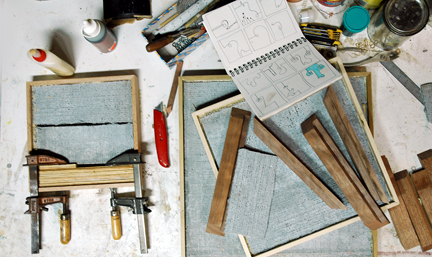About the Artist
James Shambhu is an artist living and working in Lexington, Kentucky. He received his Bachelor of Arts in 1992 and a Bachelor of Fine Arts in 1993, both from the University of Kentucky. He has had solo exhibitions at several galleries in Lexington including Tribeca Trunk, City Galery, New Editions Gallery, Ivos Gallery, and Gallerie Soleil. Mr. Shambhu was also voted one of the best new local artists by Ace Weekly in 2006 and voted into Best Visual Artist category in 2009.

Finding a great line
It’s the starting point, what makes larger, more complicated work possible. And those works could not be conceived without occasional reveling in the joy of finding a great line.
How is it that we can so often pick out figures and faces in the world around us? It’s uncanny. The most successful work happens when a line, two lines work to define the human figure. The human condition rendered in that sparseness. It can lead to greater, more complicated things — but there’s something compelling and precious in those initial sparse lines.
Figurative drawing is the source material — the base line inspiration for so much of my work. The way a curve of a fine line opens up into shadow and light — inexplicably imbued as human, by observation, by the moment. It’s an incredible connection that still fills me with intense interest and curiosity.
Black pastel. Rich paper. A fat eraser. The most primitive yet reliable of the many tools, mediums and devices I use to make art. They’re also the most reassuring in their spare pleasure.
===
Personal Essay about drawing the figure for the Lexington Herald-Leader, January 2006
I see the figure everywhere. It is my starting point, my home base. I find great comfort in its line and form, yet also find it to be continuously challenging. While it is easy to do, it is difficult to do well.
To those who ask, “Why do figurative work? Hasn’t it all been done?” The human figure has been explored in countless ways, by artists throughout the world and across the millennia. While it is often the first thing drawn by children, the human form has nevertheless been the devotion of many of the masters. Yet for all the myriad times the form has been put to paper, cast in bronze, or chiseled from granite, it still retains the power to create connections—for the artist and viewer alike, and for individuals as well as societies. There is depth here. There is emotion. There is detail to explore, grace and dignity to uncover.
When it comes to the human body, we’ll always want to look. We need to see the nude form in art so as not to lose a connection to ourselves, to humanity. Even as we enter an increasingly digital age, the organic nature of the figurative form can act as a foil against the harsh edges of technology.
Figurative drawing requires a loose sort of precision. Because we are so used to seeing the human form—in human form, as it were—even the most casual observer can’t help but notice when it’s done poorly. There is a craft to getting proportions right, and it is a never-ending part of the process.
Much of my current work explores ways that a single line can remain recognizable as human… as us. It can be surprising how a seemingly small, simple line is capable of calling up the depth of the figure to create a whole picture in the viewer’s mind.
Figurative drawing is like a signature that takes on a universal appeal, yet is completely unique.